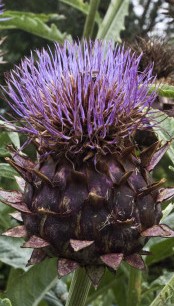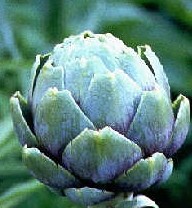 Globe artichoke is a herbaceous perennial thistle in the aster family (Asteraceae) that also includes daisies, dandelions, and sunflowers. It is native to the Mediterranean coast and grown for its edible flowerbuds as well as for its ornamental value for the back of the border. The blue green leaves are deeply lobed with spines and up to thirty two inches long. The terminal buds are carried on the main stem and side branches and are three to four inches across. Each bud consists of a fleshy edible center holding a mass of small flowers surrounded by many leathery green bracts with fleshy edible bases. When the buds open in late summer they reveal a flowerhead six inches across of azure blue to purple flowers that are fragrant and attractive to bees. Plants do best in areas with cool foggy summer such as found in coastal California. The flowerheads can be dried for use in arrangements.
Globe artichoke is a herbaceous perennial thistle in the aster family (Asteraceae) that also includes daisies, dandelions, and sunflowers. It is native to the Mediterranean coast and grown for its edible flowerbuds as well as for its ornamental value for the back of the border. The blue green leaves are deeply lobed with spines and up to thirty two inches long. The terminal buds are carried on the main stem and side branches and are three to four inches across. Each bud consists of a fleshy edible center holding a mass of small flowers surrounded by many leathery green bracts with fleshy edible bases. When the buds open in late summer they reveal a flowerhead six inches across of azure blue to purple flowers that are fragrant and attractive to bees. Plants do best in areas with cool foggy summer such as found in coastal California. The flowerheads can be dried for use in arrangements.
Type: Herbaceous perennial
Bloom: Flowerhead of small azure blue to purple flowers on edible center surrounded by many leathery green bracts with edible bases.
Size: 6.6’ H x 6.6 W
Light: Full sun
Soil: Fertile, moist, well-drained
Hardiness: Zones 7-9 with protection
Care: Fertilize monthly during the growing season; keep well watered during dry spells,cut to the ground after flowering.
Pests and Diseases: Bacterial crown rot, botrytis, curly dwarf virus, spider mites, plume moth, cabbage looper, flea beetle, army worm, aphids, slugs
Propagation: Seed, division of sideshoots
Companion plants: Knautia macedonica, Echinops bannaticus ‘Taplow Blue’,Feniculum vulgare ‘Purpureum’, Cotinus coggyrgia